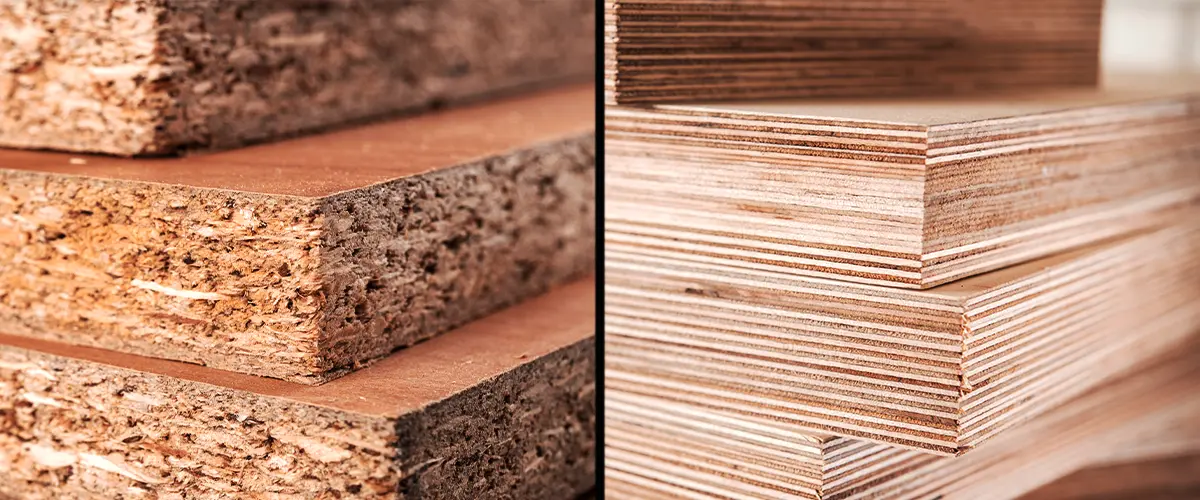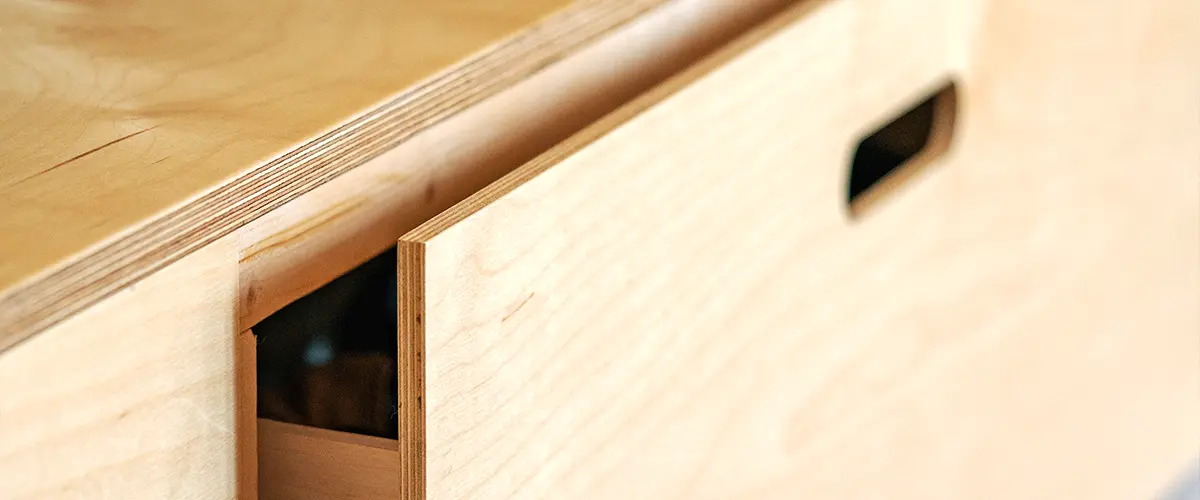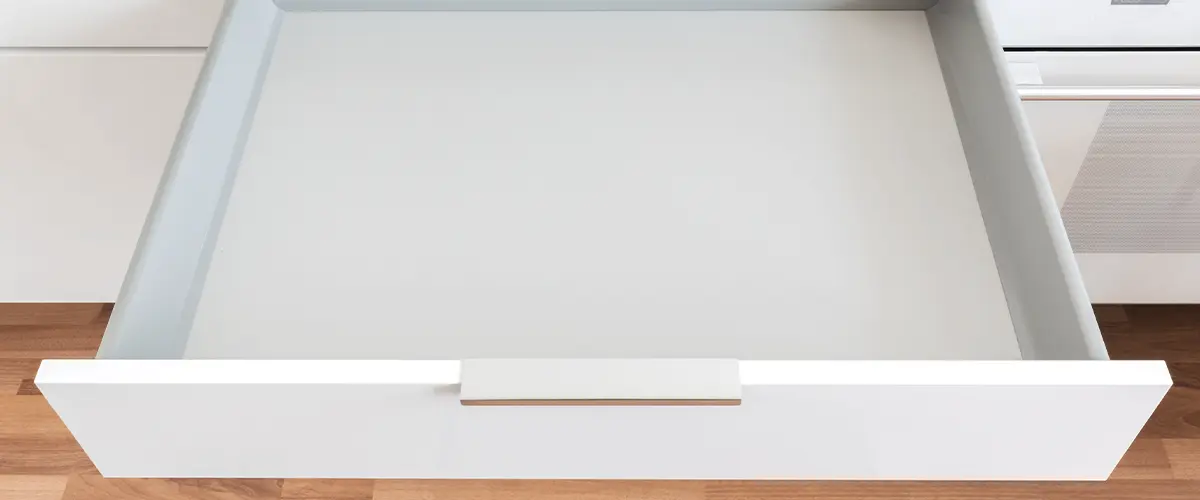Before we start, there’s one thing we need to make clear.
Furniture boards and plywood are rarely used for the same projects.
While furniture boards are almost exclusively used to build furniture, like cabinets, shelves, dressers, and so on, plywood is most commonly used in exterior wall sheathing, roofing, subfloors, and sometimes cabinets as well.
However, maybe you’re thinking about furniture board vs plywood for your new cabinets, but you’re not sure which is better. We’ll discuss that below.

Key Takeaways
- Material Distinction: Plywood for durability, furniture board for affordability.
- Plywood Strength: Resilient, durable, but pricier. Ideal for long-term investments.
- Furniture Board Drawbacks: Affordable but prone to damage, sagging. Plywood wins for reliability.
- Cost Considerations: Plywood may be expensive upfront, but it's a solid, lasting investment.
- Moisture Vulnerability: Plywood's resistance to water, a strength, but requires proper maintenance. Furniture board lacks in this aspect.
Pros and Cons of Plywood Cabinets

Stronger and more durable
Plywood cabinets stand the test of time because they’re built to withstand heavy use and wear. Each layer of wood veneer is glued together, creating a cross-grain pattern that gives the cabinet its strength and resilience.
This construction means your cabinets won’t buckle or warp under the weight of dishes or cookware. It’s a solid choice for frameless cabinets, which rely heavily on their material for structural support.
As we consider costs, we’ll see how this strength comes at a price point that reflects its superior quality.
More expensive
While the strength and durability of plywood cabinets make them a top choice for many homeowners, this cabinet material does come with a higher price tag.
Investing in plywood means paying more upfront for your cabinet construction, reflecting its superior quality and resilience compared to particle board, MDF, or furniture board.
It’s important to budget accordingly if you’re considering plywood for your kitchen cabinet materials since they represent a significant portion of a kitchen remodeling costs.
Homeowners seeking solid wood cabinets will find that despite the initial expense, plywood provides an excellent balance between durability and aesthetic appeal in furniture building.
Selecting this type of cabinet box materials may stretch your finances now, but the investment can pay off by avoiding frequent replacements or repairs down the line.
Vulnerable to water damage
Though plywood cabinets can take a hit to your wallet, they might also suffer in damp conditions. Plywood is known for having better moisture resistance than other cabinet materials like MDF or particle board.
However, prolonged exposure to water can still cause warping and swelling in plywood. Glue joints may weaken, compromising the structural integrity of your cabinetry over time.
Homeowners should consider this factor, especially if they live in humid climates or frequently use water near their cabinets. To mitigate these risks, proper sealing and finishing of the wood surfaces are crucial steps during installation.
Regular maintenance is necessary to ensure that any splashes or spills don’t lead to permanent damage on these otherwise sturdy cabinet parts.
Pros and Cons of Furniture Board

Cheaper alternative
Opting for a furniture board when constructing cabinets helps to keep costs down. It’s a popular choice among homeowners who want to save money without sacrificing the overall look of their cabinetry.
Furniture boards are typically made from compressed wood particles, which can be covered with a laminate or veneer that mimics the appearance of solid wood or other finishes.
As budget-friendly cabinet materials go, furniture board offers significant savings compared to plywood or solid wood options. This makes it an attractive option for those working within tight financial parameters.
Prone to damage and sagging
Furniture board, often used in cabinet construction due to its cost-effectiveness, unfortunately, doesn’t hold up well under stress. This material, including varieties like particle board and medium-density fiberboard (MDF), consists of compressed wood particles that can weaken over time.
Heavy loads or frequent use may cause furniture board shelves to sag, and the cabinets might show signs of wear much sooner than their plywood counterparts.
The glue joints holding the furniture board together are particularly vulnerable. In humid conditions or when exposed to liquids, these joints can swell, break down, or disintegrate completely.
Furniture boards also prove less reliable for areas subjected to spills and high humidity levels, like kitchens and bathrooms. Careful handling is essential, as any hard knocks can easily cause chips or dents in cabinet materials crafted from this more delicate substrate.
Made up of fine wood particles
Furniture boards are engineered from fine wood particles that are fused together with glue under heat and pressure to create sturdy panels. They are the foundation for many frameless cabinets found in modern homes.
However, due to its makeup, if not properly sealed, it can be more susceptible to damage from moisture compared to plywood cabinets.
Conclusion
There is no doubt that plywood is superior to furniture board for cabinets, shelving, and pretty much anything else. No matter how you look at it, the furniture board fails in most areas.
If you want a short-term solution for minimum investment, maybe particle board, MDF, or furniture board will do, but if you’d rather get a quality product that you know is reliable and lasting, plywood is the way to go.
Here at Offcut Interiors, we can help you out with your remodeling needs, regardless of the scope of work. If you have any questions, don’t hesitate to give us a ring at (480) 999-6134.
